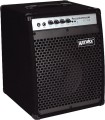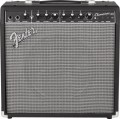Features
The instrument for which the amplifier is intended.
In general, the meaning of this paragraph is quite obvious, we note only a few nuances. So, it hardly makes sense to use an “amp” for an acoustic guitar with an electric guitar, and vice versa — these are two fundamentally different instruments with different initial sound characteristics. In addition,
combo amps for electric guitars are quite often equipped with a set of additional effects, including distortion or overdrive (see "Effects"), although there are many models without such functions. But in
devices for “acoustics”, although effects are also found, they are not so “radical” and are intended mainly for easy sound processing, and not for its fundamental distortion. In
bass amplifiers, in turn, it may be possible to connect an active electric guitar and work two instruments at once through one “amp”.
Impedance
The impedance of the speaker(s) installed in the amplifier.
Impedance is the resistance to alternating current — that is, the current flowing when an audio signal is applied. This impedance affects the compatibility of the speaker with the power amplifier: if the impedance is too low, sound distortion occurs, if the impedance is too high, the volume is reduced. However, in combo amplifiers, this parameter is most often given as a purely reference: such devices have their own power amplifier, which, by definition, is designed for the impedance of the “native” speaker, and separately, with extraneous components, the speaker and amplifier are not used.
Number of speakers
The number of speakers provided in the design of the device.
This parameter is indicated in cases where there is more than one speaker. Its meaning may vary. Thus, in some models several speakers are provided to be divided into frequency bands (see “Number of bands”); in this case, a small high-frequency emitter can be installed directly in front of the low-frequency one (the so-called coaxial circuit). In other devices, several speakers of the same type are used to provide the necessary sound power - for a number of reasons this is preferable to installing a single powerful speaker.
Number of bands
The number of bands provided in the combo amplifier. Indicated in cases where there is more than one lane.
The frequency band is called a certain part of the total frequency range, for which its speaker (or several speakers of the same type) is responsible. The division into bands makes sense from those considerations that for different frequencies (low, medium, high) the requirements for speakers will also be different: in particular, the lower the frequencies, the larger the radiator should be. Accordingly, the use of specialized speakers improves the overall sound quality of the combo.
In modern combo amplifiers, which are divided into bands, there are most often two bands — HF and LF / MF. This is considered sufficient for most cases. It is extremely rare among advanced models to meet three-band devices (HF, MF, LF), and more are considered technically unjustified.
Tweeter size
The diameter of a specialized high-frequency speaker ("tweeter") installed in the amplifier.
The diameter of the speakers is traditionally indicated in inches. For tweeters, it is usually small — about 1 – 2 ", this is due to the peculiarities of the frequency range.
Woofer size (LF/MF)
The diameter of the woofer or woofer installed in the combo amplifier. The specific value of this parameter may be different, depending on the number of lanes (see above). In three-way systems we are talking about bass dynamics, in two-way systems — about the dynamics responsible for low and medium frequencies; and if the amplifier does not have band separation, this paragraph indicates the diameter of the main radiator.
In general, the larger the radiator, the louder it can sound and the richer the bass from such a speaker is. At the same time, we note that the speaker diameter is selected by the manufacturer based on the power of the built-in amplifier and the expected sound volume. So the main indicator when choosing is still the rated power, and the size of the speaker is more of a reference value.
Number of channels
The number of channels provided in a combo amplifier or a separate “head” (see “Type”).
This parameter is specified only if the device has
more than one channel. The channel in this case can be described as a kind of “path” for the audio signal, which has its own specific set of settings. If there are several such “paths,” then each of them can be configured at your discretion and you can switch between sound options with just one click of a button (in extreme cases, by switching the instrument to another input). The most typical example of using this function looks like this: one channel is used for clean sound, and the second is used for “overdrive” using the built-in distortion or overdrive (see “Effects”). Without channel separation, the sound would have to be changed either by reconfiguring the amplifier (setting the parameters again each time, which is simply inconvenient), or by using external “gadgets” (and this is not always the best option for a number of other reasons).
As for the number of channels, in multi-channel models there are most often just two of them - this gives the mentioned additional capabilities and at the same time does not particularly affect the cost of the device. This option is optimal for beginning musicians, but is also found in professional equipment. Increasing the number of channels makes it possible to provide more advanced options for preset settings (for example, “clean ringing”
..., “clean warm”, “Crunch” and “Overdrive”), but it significantly complicates and increases the cost of the design. Therefore, the higher this number, the fewer models with such characteristics are presented on the market. The maximum value found in modern guitar amplifiers is 6; a similar amount can be found in individual professional models, mainly with a digital element base (see “Type”).Equalizer
Type of equalizer provided in the device design
An equalizer allows you to change the volume of a separate part of the sound range (frequency band), thus changing the color of the entire sound. This is one of the most important functions related to audio settings; therefore, it can be provided directly in the guitar amplifiers themselves. And the type of equalizer is indicated by the number of bands available for adjustment.
The more of these bands, the more accurately you can adjust the sound, but the more complex and expensive the equipment becomes. In light of this, the simplest option involves only
2 bands - low and high frequencies; Often such an equalizer looks like two separate knobs for adjusting the bass and treble levels. At the same time, we note that similar functionality can be found in both budget and high-end guitar amplifiers: in the second case, it is assumed that if finer adjustments are needed, you can use external equipment. However,
three-band solutions (low, mid and high frequencies) are the most popular these days: such an equalizer provides quite extensive possibilities for adjusting the sound and is relatively inexpensive (and if finer adjustments are required, you can use external equipment).
4-band equalizers are noticeably less common, but are also quite popular (including in inexpensive devices); and some models provide
...5 or more (up to 12) adjustment bands.Digital effects block
The presence of a block of digital effects in the amplifier. Note that this function can be provided in any models, not only digital ones (see "Type").
As the name implies, this function allows you to change the sound in one way or another, sometimes quite drastically. See below for the most popular effects; their specific set may be different, it should be specified separately in each model. Here we note that without this function, additional external “gadgets” will be required to work with effects.

